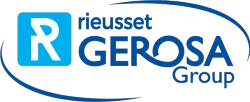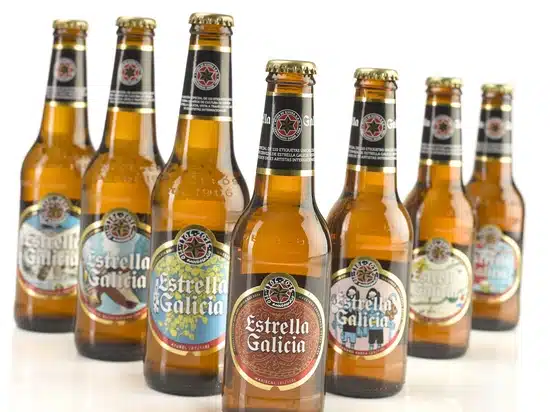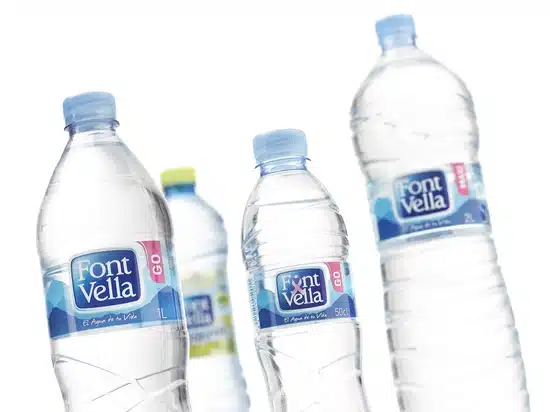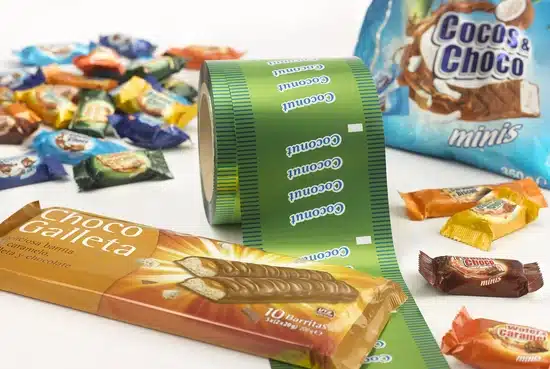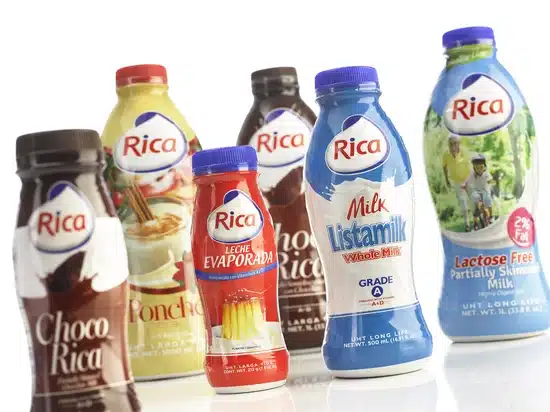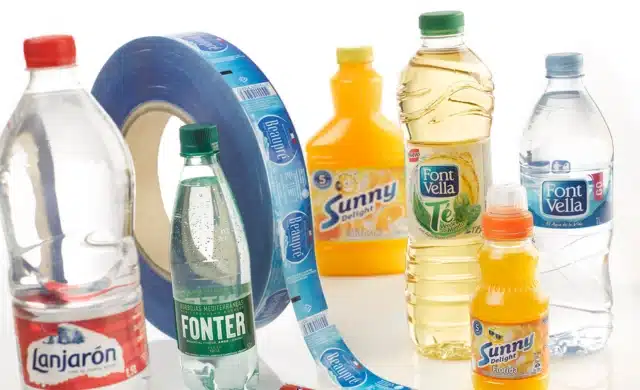
07 May Materials for flexible packaging and labels in the food and beverage sector
The food and beverage industry has strict health and safety regulations that limit the range of materials that can be used for labeling and packaging its products. These regulations are designed to ensure consumer safety and product quality.
At Rieusset, as experts in the printing of flexible packaging and labels for the food and beverage sector, we ensure compliance with all applicable regulations and mainly use the materials presented below. All of them comply with current regulations and have properties suitable to prevent contamination and ensure that they are non-toxic and do not release harmful substances to food and beverages.
Materials for labels
Two materials stand out in labels for beverage products: paper and OPP.
- Paper labels
Paper is one of the most commonly used materials for glass bottles, and in the case of beer and water brands, the preferred material is a 63 to 80 g/m2 paper, which some clients also require to be recycled and/or FSC® C129717 Certified. Especially in the beer market, labels are required to have a finish that is resistant to moisture and to soda bath – a bath that allows the bottles to be disinfected and the label to be easily removed for reuse.
These labels are usually die-cut (cut to a shape defined by the client using a die) and embossed (perforations are made in the paper creating channels that allow access of the soda bath to the glue with which the label has been adhered to the bottle to soften it and facilitate its removal from the bottle), adapting them to the branding and packaging needs.
Paper provides excellent printability for both digital and rotogravure printing, which are the two technologies currently in use at Rieusset. In addition, it allows a wide versatility of finishes, opening a creative range for designers, who can venture on more original and innovative designs that capture the attention of the final consumer. Thus, we find different textures, metallic inks, matte or gloss varnishes, etc.
In those cases where the client wants to launch a promotion, this is printed on the back side of the paper label, to which a peel-off varnish is applied, allowing the label to be easily detached from the package despite the client’s glue and without damaging it so that the consumer can read what is on the inside. If this peel-off varnish were not applied, the paper would defibrate, rendering the promotion illegible.
- OPP (Oriented Polypropylene) labels
OPP or oriented polypropylene is also a material widely used for beverage labels and at Rieusset we work with this material mainly for water and soft drink bottles. We use two types of polypropylene, depending on whether the client’s application is in reels or in bundles. For the former case we use polypropylenes between 30 and 50 microns and for the latter between 38 and 47 microns.
This material can be transparent, white or metallized and can be printed with finishes to make the label stand out on the shelf. Among the transparent materials there are also different types depending on the level of transparency desired by the client. White materials can also be chosen with different densities depending on the client’s needs, either in terms of appearance or performance. At Rieusset, we print these labels on both sides in a single pass when the client wants to communicate more things to consumers or simply to make promotions, and we print them with special inks and varnishes to make them stand out on the shelf or to give them a premium appearance (thermochromic, hydrochromic, invisible inks, matte varnishes, etc.).
This material can also be printed both with rotogravure and digital.
Furthermore, OPP is a recyclable material, and its use is aligned with the sustainability policies of many companies, especially when integrated into specific recycling programs.
Materials for flexible packaging
Flexible packaging is designed, in most cases, to contain and protect the food directly. The materials used for this purpose must meet concrete specifications depending on the product to be packaged, providing a barrier to oxygen, moisture, gases, as well as resistance to fats, oils and possible chemical reactions. In addition, the materials selected for food packaging usually require a combination of flexibility and tear resistance for proper handling.
At Rieusset we print flexible packaging, for food products, with the following materials for monofilm or multilayer solutions:
- OPP or Oriented Polypropylene, usually between 12 and 40 microns, which has good resistance to friction, humidity and condensation and offers excellent productivity in the packaging process.
- PET or Polyethylene terephthalate between 12 and 20 microns, valued for its strength and transparency, is common in food packaging. It also acts as a good barrier against gases and aromas.
- Paper between 40 and 115 g/m2, widely used in many food applications, especially now that sustainability is so much in vogue.
As we said before, the laminates or multilayers we use are those in which we combine different materials –not only those mentioned above but also others that provide new properties such as aluminum or metallized polyester– to take advantage of the properties of each one, such as the barrier against oxygen, water vapor and light, which improve the preservation of the food product.
Returning to OPP, we would also like to highlight that its impermeability and resistance offers a good barrier to moisture, oxygen and odors, which is crucial to maintain food quality and freshness. It is ideal for products that may be exposed to moisture or need refrigeration.
In addition, OPP is highly resistant to tears and punctures, ensuring that the packaging remains intact during transportation, storage and handling of the product. Due to its low static cling, it attracts less dust and dirt, enables easier handling and processing, and improves compatibility with printing and application equipment, leading to great productivity advantages, especially when used for labels.
In addition, as mentioned above, OPP is recyclable.
As for paper, it is one of the materials that is lately being used more for sustainability reasons – although this could be discussed at length as it is not always justified. Paper is generally cheaper than other packaging materials and is a cost-effective option for a wide range of applications. It is also biodegradable and, depending on the type and treatment, can be highly recyclable. Its use allows brands to demonstrate their commitment to the environment through their product packaging.
As we have already mentioned in this post, all these materials can be printed both on the front and back in rotogravure and digital printing and allow the use of inks with special effects such as iridescent, fluorescent, thermocromic, etc.
In addition to the different inks, these materials also allow the use of varnishes with soft effect or high gloss/matte contrast. Therefore, an infinite number of creative designs can be created in flexible packaging by playing with the variety of inks and varnishes that these materials allow.
OPP, PET and paper all have low solvent retention if properly processed, thus ensuring that no undesirable components are transferred to the food. These materials are usually sealed by pressure and temperature (heat), although they can also be cold sealed by adding the corresponding varnish that allows it.
Materials for sleeves
Sleeves, which are decorative sleeves that fit around the contour of a package, are materials used as secondary packaging –they are not in direct contact with the food– whose main characteristic is shrinkage with the application of heat. It is a very attractive type of labeling that makes the client’s product stand out on the shelf, providing a harmonized image of the package, as well as providing space for more information than on a label.
For sleeves, at Rieusset we use the following materials according to the client’s requirements:
- PETg is mostly transparent, glossy and easy to print. One of the most outstanding features of PETg is its controlled shrinkability. This means that it can shrink in a specific direction or uniformly, allowing sleeves to fit snugly onto containers of various shapes and sizes, ensuring a smooth, tight finish that enhances product presentation.
- OPS (Oriented Polystyrene) has excellent clarity and gloss, which enhances the visibility of printed graphics. Despite its shrink capacity, OPS is more rigid than other plastics such as PETg. This can be an advantage for products that require greater protection during shipping and handling. OPS shrinks at lower temperatures compared to other materials.
- PLA (Polylactic Acid) is of biodegradable origin, making it attractive for brands with a strong environmental commitment. Its low shrinkage temperature makes it suitable for products that should not be exposed to high temperatures during the sealing process. It provides good clarity, although it may be slightly less transparent than PET or OPS.
- Lastly, PVC is very durable and resistant. It offers excellent shrinkage and conformability to complex shapes, ensuring a smooth and tight finish. It offers good clarity and is excellent for printing high quality graphics. Compared to the above, it is the least sustainable material due to its recycling difficulties.
Do you have doubts about which material to use for labels, sleeves or flexible packaging for your products? Would you like to know more about materials suitable for the food and beverage industry? Contact us, we will be delighted to advise you.
| We Manufacture: | Meet Rieusset: |
